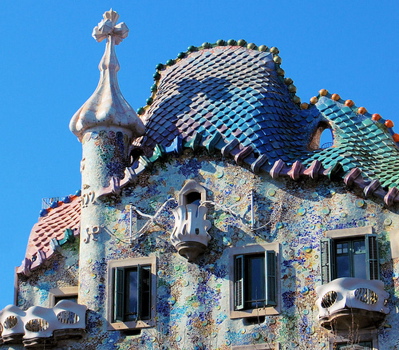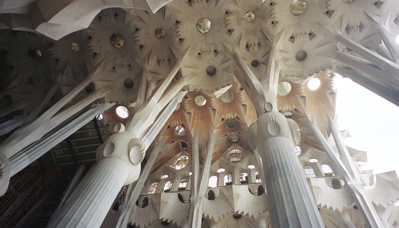
Teresa Parker blogs about restaurants, recipes, and the reasons why she's in love with Spain's food and culture.
 The Film Forum in New York City is showing Japanese director Hiroshi Teshigahara's 1984 film, "Antonio Gaudi" starting today through next Tuesday, November 4. Details and tickets are available online at the Film Forum's website. Says the Film Forum: "Less a documentary than a visual poem, Teshigahara’s ANTONIO GAUDI takes viewers on a tour of Gaudi’s truly spectacular architecture, including his massive, still-unfinished masterpiece, the Sagrada Familia cathedral in Barcelona. With camera work as bold and sensual as the curves of his subject’s organic structures, Teshigahara immortalizes Gaudi on film." And Stephen Holden wrote in the New York Times: "If any film could be described as an architectural symphony, it is Hiroshi Teshigahara's 1984 movie ANTONIO GAUDI. Much of the imagery in GAUDI is nothing less than astounding in its beauty and boldness, and the blending of a neo-Gothic mysticism and grandeur with an Art Nouveau line and a surreal apprehension of the power of nature. The erotic connotations of much of the work are so blunt as to be almost shocking." Anyone interested in digging a little deeper into the life and work of Catalonia's most famous architect, Antoni Gaudí (the film title spells the man's name in Spanish rather than in his native Catalan) should try to get his or her hands on "For the Love of Gaudí," Robert Hughes's insightful and perforce, I guess, slightly grumpy profile of the architect, his work, and the phenomenon of the Japanese obsession with both. (Published in Condé Nast Traveler, June 2004, this article is, alas, not among the online archives of the magazine.) Knowing that Gaudí in fact rejected Surrealist ideals, was a pious conservative "more Catholic than the pope," that he was the artisan son of a metal-worker, a lifelong observer of nature but a poor draftsman not handy with a T-square, knowing that what drawings he left for the Sagrada Familia were destroyed in the Spanish Civil War, and that he lived in such lonely aesceticism that when he was struck down by a streetcar in 1926 he was taken to die at the indigents' hospice, well, for me, at least, all of this adds a layer of irony that can only enrich the experience of seeing the film or the works themselves.
The Film Forum in New York City is showing Japanese director Hiroshi Teshigahara's 1984 film, "Antonio Gaudi" starting today through next Tuesday, November 4. Details and tickets are available online at the Film Forum's website. Says the Film Forum: "Less a documentary than a visual poem, Teshigahara’s ANTONIO GAUDI takes viewers on a tour of Gaudi’s truly spectacular architecture, including his massive, still-unfinished masterpiece, the Sagrada Familia cathedral in Barcelona. With camera work as bold and sensual as the curves of his subject’s organic structures, Teshigahara immortalizes Gaudi on film." And Stephen Holden wrote in the New York Times: "If any film could be described as an architectural symphony, it is Hiroshi Teshigahara's 1984 movie ANTONIO GAUDI. Much of the imagery in GAUDI is nothing less than astounding in its beauty and boldness, and the blending of a neo-Gothic mysticism and grandeur with an Art Nouveau line and a surreal apprehension of the power of nature. The erotic connotations of much of the work are so blunt as to be almost shocking." Anyone interested in digging a little deeper into the life and work of Catalonia's most famous architect, Antoni Gaudí (the film title spells the man's name in Spanish rather than in his native Catalan) should try to get his or her hands on "For the Love of Gaudí," Robert Hughes's insightful and perforce, I guess, slightly grumpy profile of the architect, his work, and the phenomenon of the Japanese obsession with both. (Published in Condé Nast Traveler, June 2004, this article is, alas, not among the online archives of the magazine.) Knowing that Gaudí in fact rejected Surrealist ideals, was a pious conservative "more Catholic than the pope," that he was the artisan son of a metal-worker, a lifelong observer of nature but a poor draftsman not handy with a T-square, knowing that what drawings he left for the Sagrada Familia were destroyed in the Spanish Civil War, and that he lived in such lonely aesceticism that when he was struck down by a streetcar in 1926 he was taken to die at the indigents' hospice, well, for me, at least, all of this adds a layer of irony that can only enrich the experience of seeing the film or the works themselves.  Film Forum, 209 West Houston St. (between 6th & Varick), NYC 212-727-8112.
Film Forum, 209 West Houston St. (between 6th & Varick), NYC 212-727-8112. Blog Category:
